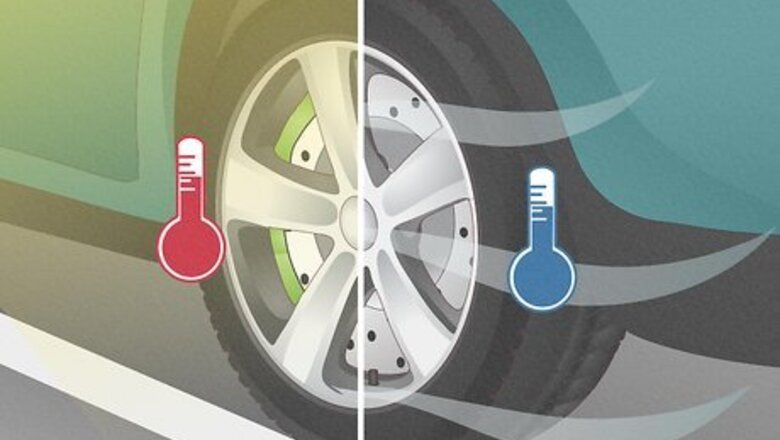
views
- The most common cause of a tire losing pressure without a visible leak is cold weather. This can easily be fixed by filling your tires with free air at a gas station or tire shop.
- Air can also escape through a deteriorated valve stem, where you would attach an air nozzle to fill up your tire. This can be repaired by a tire repair shop for around $25 to $30.
- Inspect the tire bead, or inside edge that holds the tire in place on the rim. If it’s broken or damaged, go to a tire shop right away to get the tire replaced.
Tire Losing Pressure Common Causes & Fixes

Temperature fluctuations The air inside your tires naturally expands or contracts as the temperatures rise or fall. Your tires lose about 1 pound (0.45 kg) of air per 1 square inch (6.5 cm) for every 10 °F (−12 °C) drop in air temperature. This is nothing to worry about, and can easily be fixed by filling your tires with the appropriate amount of air. Fixes: Check your air pressure each month with a tire gauge and top it off at a gas station, tire shop, or auto care store. The correct air pressure (psi or kPa) for your tires can be found in your owner’s manual or on a sticker on the lower part of your driver side door jamb. Estimated cost: Some air pressure stations and services are free. Others might charge $1 to $2 to fill your tires with air.

Natural permeation Air molecules can escape through your tires’ rubber sidewalls over time in a completely natural process called permeation. Permeation can lead to a gradual drop in tire pressure without leaving any punctures or holes in the actual tire. This can happen even if the tire isn’t driven or the tire isn’t mounted on the car. Fixes: Check your air pressure each month with a gauge and top it off at a gas station, tire shop, or auto care store. Estimated cost: Some air pressure stations and services are free, while others might charge $1 to $2 to fill your tires with air.
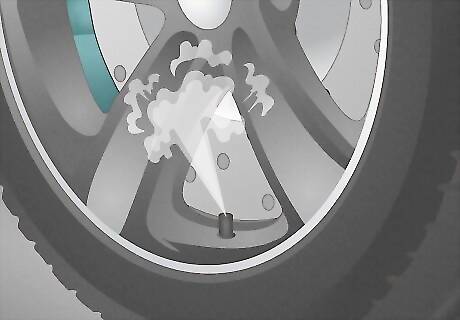
Deteriorated valve stem or core The valve stem, where you would attach an air nozzle to fill up your tire, can deteriorate and cause air pressure leaks over time. The valve can also be defective. Remove the hubcap if you have one and use a flashlight to check the stem for cracks along the stem and where it meets the wheel. Fixes: Take your car to a tire repair shop. You can also replace it yourself with a valve stem replacement tool kit by removing the wheel from the vehicle, taking the rubber wheel off the rim, removing the valve, and inserting the new one provided in the kit. Estimated cost: Tire shops can replace your valve stem for around $25 to $30. Doing it yourself can cost around $10.

Damaged wheel Damage to the metal part of the wheel, like corrosion or a bent rim, can create small gaps between the tire bead and the wheel, allowing air to escape. Check the area around the outside of the rim for corrosion (blue, green, or red discoloration) or small deformities. Fixes: If you have a bent wheel, visit a tire shop to get it straightened. If your rim is corroded, have it replaced at a tire shop or repair it yourself as a temporary fix. Jack up your vehicle, remove the tire, dismount the tire from the rim, and sand the rim down with 220 grit sandpaper. Spray it with a clear coat of paint or a car paste wax and mount the rim back on. Estimated cost: Bent rim repairs can cost between $50 to $125. New tire rims can cost between $80 to $300. 220-grit sandpaper and paint or car paste wax can cost from $20 to $30.

Broken or leaking tire bead The tire bead is the inner edge of the tire that holds the tire in place on the wheel’s rim. If the bead is damaged or not closing correctly, it can cause air leaks. This is most commonly caused by driving on tires that aren’t properly inflated, causing the bead to slip and become damaged. Fixes: Go to a tire shop right away to replace the tire. If the tire bead is damaged, it can lead to problems with your car’s ride and handling and put you at risk of a blowout. Estimated cost: Replacement tires vary depending on the vehicle and the tire’s brand and type, but the average cost is around $194 per tire.

Faulty tire pressure monitoring system (TPMS) If your TPMS says your tires have low pressure but a tire gauge says your tires are fine, it might be faulty. Most TPM systems have a pressure sensor or transmitter mounted to the wheel inside the tire’s air chamber, but some get their information by monitoring the revolution of the tires as the vehicle moves. Fixes: Take your car to a tire shop to have them replace the sensors or reset the TPM system. Tire pressure sensors generally last about 10 years before they need to be replaced. Estimated cost: The average price for tire sensors is around $40 to $60 per wheel. If you’re already getting new tires, the sensors might be less expensive to replace.

Holes or nails in the tire or sidewall It’s possible the leak is caused by a small nail or a hole you can’t see easily. You might notice lacerations, or small cuts, around where the puncture happened that allow air to escape from inside your tire. Inspect your tire for nails and spray the area with soapy water, watching for bubbles to reveal any small holes. Fixes: Visit a tire store to repair or replace the punctured tire. A puncture larger than ⁄4 inch (0.64 cm) cannot be safely repaired and requires a replacement. You can use a TPMS-safe tire sealant kit to patch up small holes so you can go get it fixed at a tire shop as soon as possible. Estimated cost: Repairs to nails or holes can cost between $54 to $64. New tires vary depending on the vehicle, but the average cost is around $194 per tire. A tire sealant kit can cost anywhere between $9 to $80.
Performing Regular Tire Maintenance
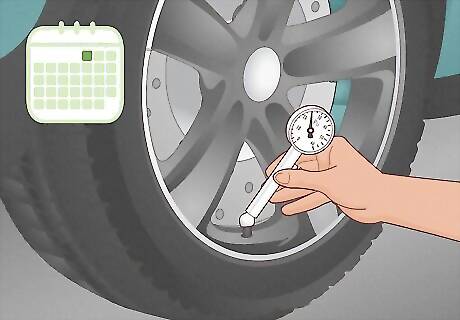
Check your tires’ pressure with a gauge each month. Find the vehicle’s recommended psi (kPa) in the driver’s side door jamb or in your owner’s manual. To check a tire’s pressure, remove the valve cap and insert the end of the gauge into the valve. If you hear air escaping, push the gauge in until it stops. View the pressure reading. If the tire pressure is low, visit an air pump at a gas station or tire shop. Push the hose’s nozzle firmly into the tire’s valve until the tire reaches the recommended tire pressure. Make sure to fill up all 4 tires to the recommended psi (kPa). Automotive specialist Ed Beery says that “uneven tire pressure [can] lead to wear problems and affect mileage.” While filling up your tires, Ed Beery also recommends making sure the “spare [tire is] in good condition with proper air pressure.”
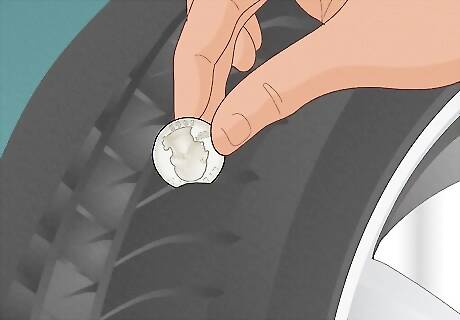
Inspect your tires for tread wear regularly with a quarter. To check your tire’s tread, place a quarter upside-down in a groove. If you see all of Washington’s head when placing the quarter in any of the grooves, it’s time to start shopping for a new tire. Use a penny to check for uneven wear. Place it upside-down in each tread groove—if you can see Lincoln’s entire head, immediately replace the tire. Automotive specialist Ed Beery recommends regularly checking your tires for uneven wear because it “indicates suspension problems.” Replace any tires over 10 years old. You can find when the tire was manufactured on the sidewall followed by the letters “DOT.” The last 4 numbers identify when a tire was made. For example, if the last 4 numbers are “3004,” the tire was manufactured on the 30th week of 2014 and needs to be replaced immediately. Check for leaks by spraying soapy water all over the tire. If you see bubbles in one area, take your car to a tire shop to repair the tire.
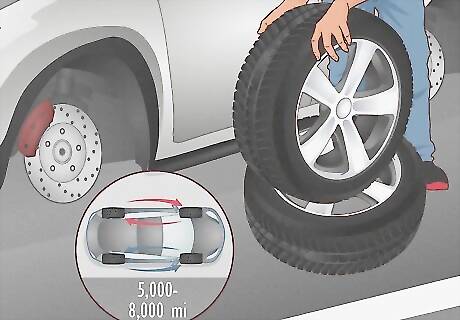
Have your tires rotated every 5,000 to 8,000 miles. Regular tire rotations can help spread wear around all 4 tires, ensuring even tread and grip. A tire technician can also inspect your tires for any leaks, cracks, or other issues and repair them. The average tire rotation can cost about $60.


















Comments
0 comment